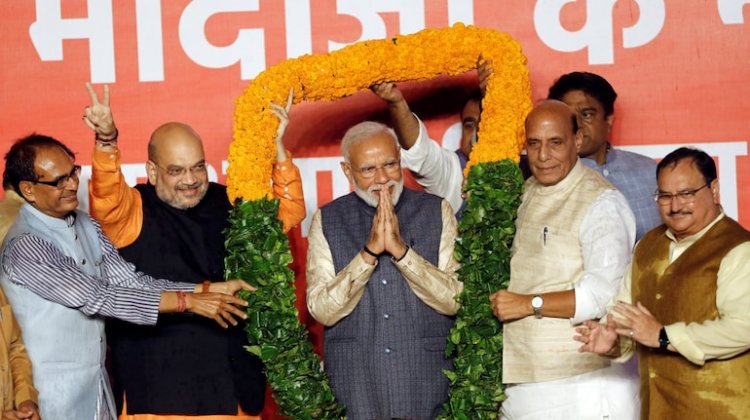BJP’s Political Strategies behind its Expanding National Footprint
Asia News Agency

The BJP plans and thinks through its political strategies. This is what makes it different from other political parties. This is also the reason for its present impressive footprint in the country.
Identifying 160 ‘vulnerable’ Lok Sabha seats
For example, changing equations in Bihar and Maharashtra, according to Nistula Hebbar (political editor at The Hindu), “have compelled the BJP to increase its list of ‘vulnerable' seats in the Lok Sabha from 144 to 160 in the party’s internal assessment, with plans already in motion to pay extra attention to these seats in the run-up to the general elections of 2024.”
On December 21, the national office-bearers of the BJP met in Patna for a two-day workshop with full-time party workers, who were dealing with 100 ‘vulnerable’ Lok Sabha seats in States such as Uttar Pradesh, Madhya Pradesh, Bihar, West Bengal, Jharkhand, Odisha, Tripura, Nagaland, Manipur and Arunachal Pradesh.
A similar meeting was held in Hyderabad on December 28 for the the remaining 60 seats. Among those categorised as ‘vulnerable’ seats, West Bengal has the largest with 24 seats, followed by Maharashtra with 11, Bihar 10, Uttar Pradesh 10, Assam five, Telangana five and Punjab three seats. Himachal Pradesh and Gujarat have one each, as do Tripura and Daman and Diu.
Gujarat: a laboratory where Modi has experimented with developing political hegemony
The important thing to note is that the above exercise is being conducted after BJP’s most impressive win in Gujarat. There is no resting. The political juggernaut must continue to role.
Sharik Laliwala (independent scholar on politics and history of Gujarat) and Christophe Jaffrelot (senior research fellow at CERI-Sciences Po/CNRS, Paris, and professor of Indian Politics and Sociology at King’s India Institute, London) identify lessons to be learnt from this victory.
First, “no party has ever won 156 seats out of 182 in the state. Second, the state’s political trajectory has been followed by most of the rest of northern and western India since 2014, with Narendra Modi’s BJP dominating the Lok Sabha elections. In that sense, Gujarat is more than a model. It is a laboratory — the state where Modi has experimented with developing political hegemony.
Popularity among all castes and classes: “In the last Gujarat election, this hegemony found expression in the BJP’s capacity to attract voters from every social group in equal proportion.” While the BJP remains an upper/dominant caste party, the OBCs (Other Backward Classes), even ‘Adivasis’ (tribals) and Dalits rallied around it. This, write the two authors “spells trouble for Congress, which has traditionally been the political outfit for OBCs, Dalits and ‘Adivasis’ in Gujarat. The role of caste as the only variable for explaining voting patterns is clearly eroding – like in the last Lok Sabha elections.”
BJP above accountability in socio-economic terms: Interestingly, note the authors, the BJP is improving its electoral performance in, a priori adverse circumstances as most social indicators showed no improvement. While Gujarat continues to register remarkable growth rates and attract industrial investments, these achievements do not benefit society at large.” For example, the percentage of underweight children has increased to 39.7 per cent. As a result, Gujarat ranks 29th out of 30 states on this indicator. The Adjusted Net Enrolment Ratio in elementary education is not improving either and Gujarat is ranked 21 here. All this and more, could have dented BJP’s popularity. “But the party is above accountability in socio-economic terms — like at the national level.”
Pan-India modus operandi: Based on the Gujarat model, PM Modi has invented a pan-India modus operandi that “relies on techniques of concentration of power, which include the sidelining of opponents not only on the political scene but also within the party….”
Besides, “Modi has won elections one after the other by saturating the public sphere with the message: I am here for you.” After the Gujarat win in 2014, Modi tweeted ‘India has won!’ (because he had won).
Opposition helping BJP: The two authors however, qualify their arguments. “First, the division in the Opposition is helping BJP establish its hegemony, as evident from the entry of AAP in Gujarat and the shrinking of UPA on the national scene. Second, BJP is not attracting voters from each and every caste only because of Hindu majoritarianism. The party selects its candidates in a very sophisticated manner…..
BJP’s sense of social arithmetic: “The BJP’s sense of social arithmetic suggests that caste still needs to be factored in. It may play a more significant role again because the BJP concentrates ministerial power in the hands of dominant caste politicians. In Gujarat, it has appointed 10 ministers from OBC-SC-ST backgrounds, but it continues with a Patel chief minister and the most influential ministries, like home, finance, revenue, energy-petrochemicals, roads and buildings, remain in the hands of forward castes. Executive power is still with the forward castes, while others are accommodated only in the legislature.”
















